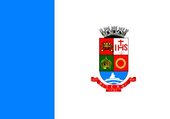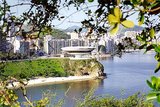|
|
Niterói is a city in Brazil, in the state of Rio de Janeiro. The population is circa 440,000. The municipality spreads over 130 km˛ (50.19 square miles). The geographic coordinates are Template:Coor dms.
The city was founded on November 22, 1573 by a Tupi Indian named Araribóia (who later received the Christian name of Martim Affonso de Souza). It is the only Brazilian city to have been founded by an Indian.
After the war with France for the Guanabara Bay (in the so-called France Antarctique episode), Araribóia requested from the Governor-General, Mem de Sá, a piece of land, which he called "Banda D'Além" ("land beyond"). His request was granted, and the village of "Săo Lourenço dos Índios", Niterói's first name, was born.
In 1819, the village was recognized as such by the central government, and received the new name of "Vila Real da Praia Grande" (Royal Village of Long Beach), which occupied only the area where today the centre of the city is. It only begun expanding beyond those limits in the late 19th century, when a tramway service begun circulating, allowing the expansion of urban construction. In the early 20th century, the city started its industrialization boom.
Niterói_Itacoatiara_Beach.jpg
During the period (1834 - 1975) when Rio de Janeiro was divided in two states: Rio de Janeiro and State of Guanabara (Federal District), where the national capital was, Niterói served as the capital of Rio de Janeiro State (between 1834-1894 and 1903-1975; during the period comprised between 1894 and 1903, the city of Petrópolis was the state capital), which on March 15, 1975 was remerged with the State of Guanabara (correspondent to the city of Rio de Janeiro). The city was elevated to state capital by the Ato Adicional of 1834.
Anciently spelled Nictheroy, the name means "hidden waters" in the Tupi language and was officially changed to "Niterói" on March 6, 1835 (from its last official name, "Vila Real da Praia Grande", with the old spelling, which persisted until the mid-20th century), in which occasion it was elevated to the category of city (until then, it was officially a village). It is within 5 km (3.1 miles) of the Rio de Janeiro city, to which it is linked by the Rio-Niterói Bridge and a Ferry service. Quality of life in Niterói is one of the best (3rd place) among 5,600 Brazilian cities according to UN standards. The Niterói Contemporary Art Museum, the city's landmark, was designed by the famous Brazilian modernist architect Oscar Niemeyer.
In the early 1990s, the administrative division of Niterói was altered.da:Niteroi de:Niterói es:Niterói fr:Niterói it:Niterói nl:Niterói no:Niterói pt:Niterói


